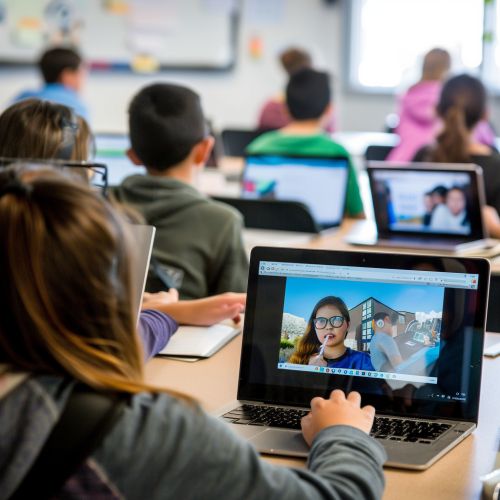Online education
Introduction


Online education, also known as e-learning or distance learning, is a mode of delivering educational instruction and content through digital platforms. This approach leverages the internet to provide a flexible and accessible learning environment, enabling students to engage with educational material from virtually any location. Online education encompasses a wide range of formats, including fully online courses, blended learning, and massive open online courses (MOOCs).
History of Online Education
The concept of online education can be traced back to the early days of the internet. The first instances of distance learning date back to the 19th century, with correspondence courses delivered via postal mail. However, the advent of the internet in the late 20th century revolutionized the field. The University of Phoenix was among the first institutions to offer online degree programs in the 1990s. By the early 2000s, advancements in technology and increasing internet penetration facilitated the rapid growth of online education.
Technological Foundations
Online education relies on several key technologies:
Learning Management Systems (LMS)
A Learning Management System (LMS) is a software application that provides the framework for managing, delivering, and tracking educational content. Examples of popular LMS platforms include Moodle, Blackboard, and Canvas. These systems support various functionalities such as course creation, student enrollment, assessments, and communication tools.
Video Conferencing Tools
Video conferencing tools like Zoom, Microsoft Teams, and Google Meet have become integral to online education. These platforms enable real-time interaction between instructors and students, facilitating live lectures, discussions, and collaborative activities.
Multimedia Content
The use of multimedia content, including videos, animations, and interactive simulations, enhances the learning experience. Platforms like YouTube and Khan Academy offer a wealth of educational videos that can be integrated into online courses.
Pedagogical Approaches
Online education employs various pedagogical approaches to cater to diverse learning needs:
Synchronous Learning
Synchronous learning involves real-time interaction between instructors and students. This approach mimics traditional classroom settings, with scheduled live sessions where participants can engage in discussions and ask questions. Synchronous learning fosters a sense of community and immediate feedback.
Asynchronous Learning
Asynchronous learning allows students to access course materials and complete assignments at their own pace. This approach provides flexibility, enabling learners to balance their studies with other commitments. Discussion forums, pre-recorded lectures, and self-paced modules are common elements of asynchronous learning.
Blended Learning
Blended learning combines online and face-to-face instruction. This hybrid model leverages the strengths of both approaches, offering the flexibility of online education while maintaining the personal interaction of traditional classrooms. Blended learning is particularly effective in enhancing student engagement and learning outcomes.
Advantages of Online Education
Online education offers several advantages:
Accessibility
Online education breaks down geographical barriers, providing access to quality education for students in remote or underserved areas. It also accommodates learners with disabilities by offering customizable learning environments.
Flexibility
The flexibility of online education allows students to learn at their own pace and schedule. This is particularly beneficial for working professionals, parents, and individuals with other commitments.
Cost-Effectiveness
Online education can be more cost-effective than traditional education. It eliminates the need for physical infrastructure and reduces expenses related to commuting, housing, and printed materials.
Challenges of Online Education
Despite its benefits, online education faces several challenges:
Digital Divide
The digital divide refers to the gap between individuals who have access to modern information and communication technology and those who do not. This disparity can hinder the effectiveness of online education, particularly in low-income or rural areas.
Student Engagement
Maintaining student engagement in an online environment can be challenging. The lack of face-to-face interaction may lead to feelings of isolation and decreased motivation. Instructors must employ innovative strategies to keep students engaged and motivated.
Quality Assurance
Ensuring the quality of online education is crucial. Institutions must adhere to rigorous standards and accreditation processes to maintain the credibility and effectiveness of their programs. Quality assurance mechanisms include regular assessments, peer reviews, and feedback from students.
Future Trends in Online Education
The future of online education is shaped by several emerging trends:
Artificial Intelligence (AI)
Artificial Intelligence (AI) is poised to revolutionize online education. AI-powered tools can personalize learning experiences, provide real-time feedback, and automate administrative tasks. Adaptive learning platforms use AI algorithms to tailor content to individual learning styles and needs.
Virtual Reality (VR) and Augmented Reality (AR)
Virtual Reality (VR) and Augmented Reality (AR) technologies offer immersive learning experiences. VR can simulate real-world environments, providing hands-on training in fields such as medicine and engineering. AR enhances learning by overlaying digital information onto the physical world.
Microlearning
Microlearning involves delivering content in small, manageable chunks. This approach caters to the modern learner's preference for short, focused learning sessions. Microlearning is particularly effective for skill-based training and professional development.
Conclusion
Online education has transformed the landscape of learning, offering unprecedented access and flexibility. While it presents certain challenges, ongoing advancements in technology and pedagogy continue to enhance its effectiveness. As the field evolves, online education will play an increasingly vital role in shaping the future of education.
